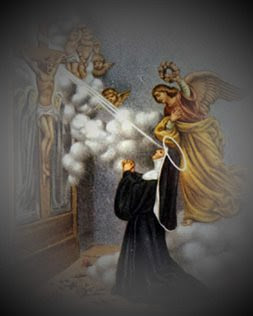St. Rita of Cascia, Patron Saint of the Impossible
Today (Saturday 22 May 2010) we remember the life and works of St. Rita of Cascia, Patron Saint of the Impossible.
St. Rita of Cascia was born in 1381 in the village of Roccaporena near Cascia in Italy. She was the only child of Antonio and Amata Lotti who were already advanced in age when Rita was born.
From an early age, Rita dreamed of being a nun. She frequented the convent of the Augustian nuns of Cascia. However, her parents had other dreams for her. They arranged her marriage to Paolo Mancini when she was only 12 years old. She bore two sons, a twin, named Giangiacomo Antonio and Paolo Maria. Rita taught his sons Catholic values but they chose to follow the immoral ways of their father. As a watchman of the town in Cascia, Mancini often found himself drawn into the conflict of two political factions, the Guelps and the Ghibellines. For 18 years, Rita had to put up with his abuse and infidelity.
Through Rita’s prayers, Mancini was converted. Unfortunately, as he worked on his reformation, he was ambushed and killed.
Her sons wanted to avenge their father’s death. Rita knew that vengeance was wrong but her persuasion came to no avail. So, she prayed to God to just take away the lives of her sons, rather than see them commit murder. Tradition says that God heard Rita’s voice because a year later, her sons died of natural causes, but only after they had received the last Sacraments.
With no more family responsibilities, Rita did what she had desired since her childhood – to join the Augustinian Nuns of St. Mary Magdalene Monastery. At first, her admission was denied because virginity was required for entry into the convent and some of the religious of the community belong to the political group responsible for her husband’s death. However, Rita was persistent. She implored the help of her three patron saints, John the Baptist, Augustine, and Nicholas of Tolentino, to assist her. She worked for the establishment of peace between the hostile parties of Cascia and succeeded. She soon was allowed to enter the monastery.
She was 36 years old.
Rita followed the ancient Rule of Saint Augustine. She devoted herself to prayer, works of charity, took pains to maintain peace and harmony among the citizens of Cascia.
She desired that more and more become intimately joined to the redemptive suffering of Jesus and her desire was satisfied in an extraordinary way. When she was about 60 years old, while she was meditating before the image of Jesus crucified, a small wound appeared on her forehead, like one made by a thorn from the crown that encircled Jesus’ head. She bore the pain in the next 15 years. In spite of the pain, she constantly experienced, she offered herself courageously for the physical and spiritual wellbeing of others.
A few months before her death, one of her visitors asked if she had any special requests, Rita asked that a rose from the garden of her parent’s home be brought to her. That was impossible to fulfill because roses do not bloom in January. But to the amazement of the person being requested, a single brightly colored blossom appeared on a rose bush just as the nun had said. It was brought to Rita who gave thanks to God for His sign of love.
Her last words before her death on May 22, 1457 were, “Remain in the holy love of Jesus. Remain in obedience to the holy Roman church. Remain in peace and fraternal charity.” Her body was placed in a glass case and was put on display at the Basilica of St. Rita in Cascia in Italy. She was beatified in 1627 by Pope Urban VIII and canonized on May 24, 1900, by Pope Leo XIII.
As we venerate St. Rita of Cascia on her feast day, let us be inspired by her example. Let us remain in constant communication with God through our prayers and be charitable at all times.


















